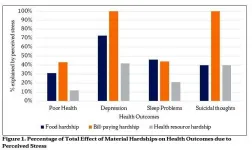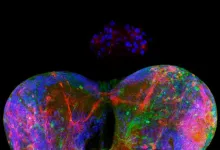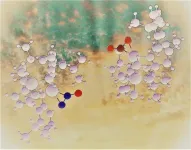INFORMATION:
In addition to Jiang, authors of the manuscript at Georgetown include Fan Nils Yang, Margarita Bronshteyn, Sarah A. Flowers, Princy Kumar, G. William Rebeck and R. Scott Turner. Other authors include Matthew Dawson, David J. Moore, and Ronald J. Ellis at the University of California, San Diego.
Author and his/her co-authors report having no personal financial interests related to the study.
This research was supported by grant (1R01MH108466) from the National Institutes of Health.
About Georgetown University Medical Center
Georgetown University Medical Center (GUMC) is an internationally recognized academic health and science center with a four-part mission of research, teaching, service and patient care (through MedStar Health). GUMC's mission is carried out with a strong emphasis on public service and a dedication to the Catholic, Jesuit principle of cura personalis -- or "care of the whole person." The Medical Center includes the School of Medicine and the School of Nursing & Health Studies, both nationally ranked; Georgetown Lombardi Comprehensive Cancer Center, designated as a comprehensive cancer center by the National Cancer Institute; and the Biomedical Graduate Research Organization, which accounts for the majority of externally funded research at GUMC including a Clinical and Translational Science Award from the National Institutes of Health. Connect with GUMC on Facebook (Facebook.com/GUMCUpdate), Twitter (@gumedcenter).
Immune-compromised people with HIV, APOE4 gene may have a compounded risk for Alzheimer's
2021-02-22
(Press-News.org) WASHINGTON (Feb. 22, 2021) --- People living with the human immunodeficiency virus (HIV) who have a history of severe immunosuppression and at least one copy of the Alzheimer's disease-related gene variant APOE4, might see a compounded adverse effect on the circuitry that impacts memory. This could eventually lead to an increased risk for dementia after age 65, according to Georgetown University Medical Center investigators and colleagues.
The researchers used MRI scans to examine the brain, with a focus on two regions - the hippocampus, which is critical for memory and is often affected in Alzheimer's disease, and the caudate nucleus, which sits deep in the center of the brain and is often affected in people with HIV. Based on the MRI images, they found that connectivity between the two regions was affected by APOE4 in people with HIV. A history of severe immunosuppression further exacerbated the impact of APOE4.
The finding appears online this month in the journal AIDS.
"We know that the hippocampus plays a critical role in memory and the caudate is a key region involved in HIV-associated neurocognitive disorders," said Xiong Jiang, PhD, an assistant professor at Georgetown who heads the Cognitive Neuroimaging Laboratory. "We wanted to understand whether HIV disease and APOE4 may concomitantly and/or interactively affect these areas of brain function."
The AIDS crisis began in mostly young men in the early 1980s, and by now nearly half of people living with HIV in the U.S. today are 50 or older. There have been significant advances in therapies for HIV that help account for the older survivors, including a combination antiretroviral therapy, or cART. This therapy stops HIV infection from progressing to full-blown AIDS in many people and transforms HIV-infection from a rapidly fatal illness to a chronic, manageable condition. Despite the advent of cART, people living with HIV can still develop neurological conditions known as HIV-associated neurocognitive disorders. Longevity now poses emerging additional risks related to other brain-related diseases, including Alzheimer's.
To try to better understand this risk, the researchers recruited 104 people with HIV from the Washington, DC, metropolitan area. To image areas of memory and other brain functions, the clinicians used resting-state functional MRI where no tasks or stimuli were given during the scan.
The investigators found that APOE4 was associated with reduced functional connectivity (the ability of two distinct areas of the brain to communicate) between the hippocampus and the caudate in people with HIV. This reduced functional connectivity was associated with poorer memory function. Importantly, a history of severe immunosuppression led to further reduction in functional connectivity that contributed to reduced memory performance in APOE4 carriers, but not in APOE4 non-carriers. The investigators concluded that a history of severe immunosuppression may compound the effects of APOE4. They also found that executive function, primarily the ability to conduct everyday chores, was not impaired in these same people.
Most treatments in development for Alzheimer's are focusing on signal pathways related to the hippocampus and associated regions, where new memories are formed and where the earliest signs of the disease are seen. However, in people with HIV, this study suggests that in addition to the hippocampus, the regions they identified, such as the caudate, might need to be considered and included in a treatment plan.
"A helpful study would be to compare HIV-positive people ages 18 to 40 with those over age 70 to investigate whether, and how, age interacts with APOE4 and HIV disease in affecting brain function," said Jiang. "Also, we're exploring a possible therapeutic investigation that uses transcranial direct current stimulation. A constant electrical current is delivered via electrodes placed on the scalp that indirectly stimulates the caudate or hippocampus of people with HIV to try to lessen functional deterioration of memory."
ELSE PRESS RELEASES FROM THIS DATE:
Cancer control: Non-DNA changes induce metabolism variations in hepatocellular carcinomas
2021-02-22
Cancer cells acquire growth advantages over normal cells in myriad ways. Changes in cell programming allow these cells to grow in an uncontrolled fashion, thereby forming the cancer mass. Hepatocellular carcinoma (HCC), being highly malignant and invasive with a high recurrence rate and drug resistant phenotype, is one of the most dreadful cancers. Understanding the underlying molecular mechanisms is crucial to design therapeutic interventions and to predict patient prognosis.
Cancer cells use metabolic, immunogenic, or growth-related strategies, which can be controlled by a number of alterations in the cell process. Of these, "post-transcriptional RNA modification" has recently sparked interest among cancer biologists. ...
Material hardship taking a mental and physical toll on young adults during pandemic
2021-02-22
Syracuse, N.Y. - As the United States approaches the one-year anniversary of the start of COVID-19 lockdowns, a new study by researchers from Syracuse University and the University of Texas at San Antonio shows that material hardship - difficulty paying for food, bills and healthcare - is taking a toll on the mental and physical health of young adults.
In the study, " END ...
UConn researcher offers lessons learned from a pre-pandemic study of telemedicine use
2021-02-22
With the onset of the COVID-19 pandemic, telemedicine has become a new norm for many routine and non-emergency medical needs. But there are lessons to be learned from telemedicine's use - or lack thereof - prior to the pandemic, and a new study from a UConn School of Social Work researcher offers insight for policymakers, administrators, and public health officials when considering the implementation of new services.
A qualitative researcher, lead author and licensed clinical social worker Kelsi Carolan was brought into the study - which was conducted in 2017 and 2018 and was recently published in the Journal of Medical Internet Research - to examine the adoption of a telemedicine program in a California independent senior ...
Study suggests teacher-student bonds may be especially important for homeless kids
2021-02-22
A recent study of homeless preschoolers found a strong correlation between the bonds those children formed with teachers and the children's risk of behavioral and emotional problems.
"It's well established that children who are homeless are at higher risk of a wide variety of negative outcomes," says Mary Haskett, corresponding author of the study and a professor of psychology at North Carolina State University. "However, there's a lot of variability within this group. We wanted to learn more about what makes some of these children more resilient than others."
For ...
Discovery of a mechanism by which epithelial tumours cause developmental delays
2021-02-22
The systemic balance that coordinates the growth of an organism and its progress through the different stages of development occurs across the animal world and is regulated by internal and external signals. Examples of this balance are puberty in humans and metamorphosis in flies. These are transitions characterised by the production of steroid hormones and they mark the turning point that will determine the halting of growth and entry into the adult state. Certain human diseases, such as cancer and inflammatory bowel diseases (IBDs), cause a delay in this transition.
Led by Dr. Marco Milán, scientists at IRB Barcelona ...
How a gene called HAND2 may impact the timing of labor
2021-02-22
BUFFALO, N.Y. -- A new study illuminates how a gene called HAND2 may have a hand in the timing of human labor.
"We don't know why humans go into labor. It's a basic aspect of human biology that we just don't know the answer to, and it's kind of embarrassing that we don't," says senior author Vincent Lynch, an evolutionary biologist at the University at Buffalo. "What happens in many other animals is that as gestation goes on, the level of progesterone keeps going up, and then a few hours before birth, progesterone levels drop to pre-pregnancy levels. Progesterone inhibits contractions, so once you lose it, the uterus starts contracting and the baby is born.
"But in ...
Unique study of isolated bobcat population confirms accuracy of extinction model
2021-02-22
The reintroduction of 32 bobcats to an island off the coast of Georgia more than three decades ago created an ideal experiment to examine the accuracy of a genetic-modeling technique that predicts extinction of isolated wildlife populations.
That's the conclusion of Penn State researchers who continue to monitor the bobcat population on Cumberland Island National Seashore, and who conducted a study comparing and contrasting the Cumberland Island bobcats to a population of bobcats on Kiawah Island off the coast of South Carolina.
The research was led by Cassandra Miller-Butterworth, associate professor of biology at Penn State Beaver, and Duane Diefenbach, Penn State adjunct professor of wildlife ecology who, as a doctoral ...
Synthesis of a rare metal complex of nitrous oxide opens new vistas for
2021-02-22
Like its chemical relative carbon dioxide (CO2), nitrous oxide (N2O) is an important greenhouse gas and the dominant ozone-depleting substance emitted in the 21st Century. Consequently, strategies for limiting its emissions and its catalytic decomposition with metals are being developed. A recent study indicates that nitrous oxide can bind to metals similarly to carbon dioxide, which helps to design new complexes with even stronger bonding. This could allow the use of nitrous oxide in synthetic chemistry or help to degrade it to substances harmless to the atmosphere. The results were reported in the journal Angewandte Chemie International Edition as a Very Important Paper on February 17th 2021.
A comprehensive analysis of the global N2O budget has ...
Researchers discover potential new therapeutic targets on SARS-CoV-2 Spike protein
2021-02-22
UNIVERSITY PARK, Pa. -- The COVID-19 pandemic has prompted considerable investigation into how the SARS-CoV-2 Spike protein attaches to a human cell during the infection process, as this knowledge is useful in designing vaccines and therapeutics. Now, a team of scientists has discovered additional locations on the Spike protein that may not only help to explain how certain mutations make emerging variants more infectious but also could be used as additional targets for therapeutic intervention.
"Significant research is underway to examine how the receptor binding domain (RBD) at the tip of the club-shaped SARS-CoV-2 Spike protein attaches to an ACE2 receptor on a ...
Positive vibes only: Forego negative texts or risk being labelled a downer
2021-02-22
A new study from researchers at the University of Ottawa's School of Psychology has found that using negative emojis in text messages produces a negative perception of the sender regardless of their true intent.
Isabelle Boutet, a Full Professor in Psychology in the Faculty of Social Sciences, and her team's findings are included in the study 'Emojis influence emotional communication, social attributions, and information processing' which was published in Computers in Human Behavior.
Study background: Eye movements of 38 University of Ottawa volunteer undergraduate student participants were tracked and studied, and the volunteers were shown sentence-emoji pairing under 12 different conditions where sentences could be negative, positive, ...




